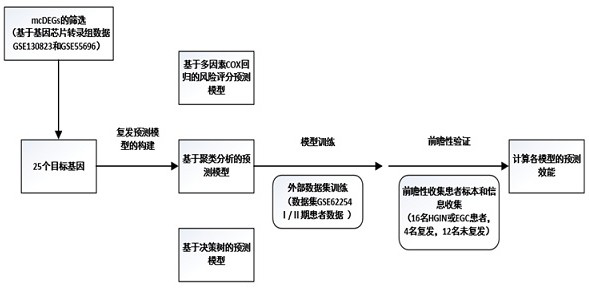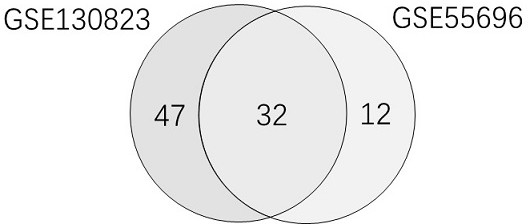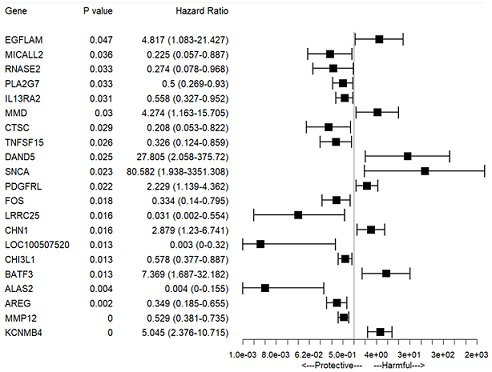Prognostic difference genes and recurrence prediction model in early gastric cancer
An early gastric cancer and gene technology, applied in the field of biodiagnosis, can solve the problems of lack of tumor recurrence prediction model and less research at the gene level.
- Summary
- Abstract
- Description
- Claims
- Application Information
AI Technical Summary
Problems solved by technology
Method used
Image
Examples
Embodiment 1
[0023] Example 1: The flow of this study
[0024] In this study, firstly, from the two sets of gene chip transcriptome data (GSE130823 and GSE55696), we screened out gastritis / control tissue → low-grade intraepithelial neoplasia (LGIN) → high-grade intraepithelial neoplasia (High-grade intraepithelial neoplasia (LGIN) grade intraepithelial neoplasia (HGIN)→Monotonically changing differentially expressed genes (mcDEGs) in EGC, and mcDEGs potentially associated with tumor recurrence were screened out by T test and single factor COX regression analysis. Then, the stage I / II patients in the external data set GSE62254 containing prognosis data were used as the training set, and the mcDEGs obtained from the screening were used as the training variables. The predicted outcome was tumor recurrence, and a recurrence prediction model based on the decision tree algorithm was constructed. Furthermore, 16 HGIN or EGC patients were prospectively collected as a validation set (4 relapsed, 12...
Embodiment 2
[0025] Example 2 The basic clinical information of the included research patients
[0026]A total of 94 samples were included in the first batch of gene chip samples. The subjects of the study were patients diagnosed with LGIN, HGIN or EGC in the Gastroenterology Department of Peking Union Medical College Hospital from 2011 to 2015. The test results were stored in the Gene Expression Comprehensive Database with the registration number GSE130823. A total of 77 samples were included in the second batch of gene chip samples. The research subjects were patients diagnosed with LGIN, HGIN, EGC and gastritis in the Department of Gastroenterology of Peking Union Medical College Hospital from March 2010 to May 2013, and the registration number was GSE55696. A total of 16 patients and 32 samples were included in the third batch of patients in the validation set. The patients were patients who visited the Department of Gastroenterology of Peking Union Medical College Hospital from Janu...
Embodiment 3
[0027] Example 3 Training and Verification of Risk Score Prediction Model Built Based on Multi-factor COX Regression Analysis
[0028] When screening mcDEGs in the early stage, the data of stage I / II patients in the external data set GSE62254 were used by single factor COX analysis, with recurrence as the outcome, and mcDEGs that were significantly related to the outcome were screened out. Corrplot package (0.88) in R language was used to further test the correlation of each mcDEGs, and the mcDEGs related to recurrence were included in LASSO regression analysis using glmnet package (4.1.1) to eliminate unnecessary or multicollinear genes. Then, multivariate COX regression analysis was performed on the remaining genes to determine whether these genes had a significant impact on recurrence, and a formula was constructed to calculate the patient's risk score. The risk score calculation formula used in the study is as follows: risk score=∑(X J*coef J), where X J is the normalized ...
PUM
| Property | Measurement | Unit |
|---|---|---|
| Sensitivity | aaaaa | aaaaa |
Abstract
Description
Claims
Application Information
 Login to View More
Login to View More - R&D
- Intellectual Property
- Life Sciences
- Materials
- Tech Scout
- Unparalleled Data Quality
- Higher Quality Content
- 60% Fewer Hallucinations
Browse by: Latest US Patents, China's latest patents, Technical Efficacy Thesaurus, Application Domain, Technology Topic, Popular Technical Reports.
© 2025 PatSnap. All rights reserved.Legal|Privacy policy|Modern Slavery Act Transparency Statement|Sitemap|About US| Contact US: help@patsnap.com



